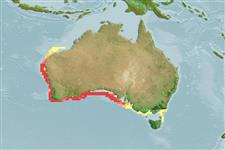Environment: milieu / climate zone / depth range / distribution range
Ecology
Marine; benthopelagic; depth range 80 - 300 m (Ref. 33839). Subtropical
Eastern Indian Ocean: southern Australia.
Size / Weight / Age
Maturity: Lm ? range ? - ? cm
Max length : 51.0 cm TL male/unsexed; (Ref. 33839)
Short description
Identification keys | Morphology | Morphometrics
Dorsal spines (total): 6; Dorsal soft rays (total): 13 - 14; Anal spines: 4; Anal soft rays: 12 - 13. Red with numerous horizontal white lines on sides; eyes yellow; unpaired fins reddish, caudal with broad, intensely red stripe on each lobe; pelvic fins whitish, pectorals mostly transparent (Ref. 33839).
Found on the continental shelf (Ref. 75154).
Life cycle and mating behavior
Maturity | Reproduction | Spawning | Eggs | Fecundity | Larvae
Gomon, M.F., C.J.M. Glover and R.H. Kuiter (eds.), 1994. The fishes of Australia's south coast. State Print, Adelaide. 992 p. (Ref. 33839)
IUCN Red List Status (Ref. 130435: Version 2024-1)
Threat to humans
Harmless
Human uses
Fisheries: bycatch
Tools
Special reports
Download XML
Internet sources
Estimates based on models
Preferred temperature (Ref.
123201): 13.9 - 20.3, mean 15.8 °C (based on 17 cells).
Phylogenetic diversity index (Ref.
82804): PD
50 = 0.5088 [Uniqueness, from 0.5 = low to 2.0 = high].
Bayesian length-weight: a=0.01288 (0.00587 - 0.02825), b=3.03 (2.84 - 3.22), in cm total length, based on LWR estimates for this (Sub)family-body shape (Ref.
93245).
Trophic level (Ref.
69278): 4.0 ±0.6 se; based on size and trophs of closest relatives
Resilience (Ref.
120179): Very Low, minimum population doubling time more than 14 years (Preliminary K or Fecundity.).
Fishing Vulnerability (Ref.
59153): Moderate vulnerability (40 of 100).
